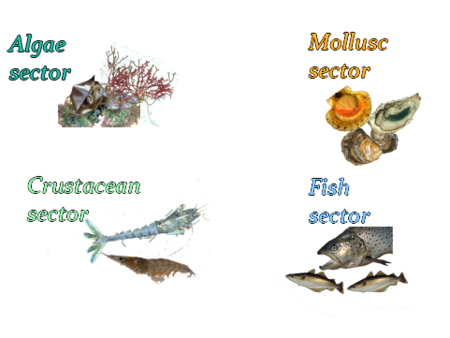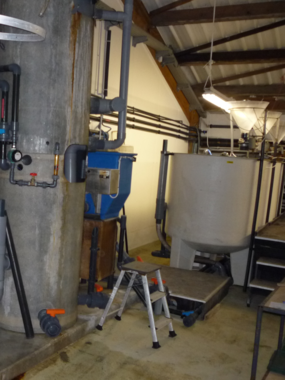Recirculating systems: Advantages and examples of utilisation
Aquaculture Fact Sheet - September 2009
http://en.aquaculture.ifremer.fr/Info.-Card
Introduction
Recirculating systems have been developed for fish farming over the last 20 years and the extent of their adoption by the industry has progressively grown from use in hatcheries (breeders, eggs, larvae and fry) to the growout phase of production.
Fresh water and marine systems work on the same principles and allow water quality of the rearing environment to be controlled and the entry of pathogens to be minimised. The discharged water carrying wastes goes through a series of purification and regulation treatments before being partially or totally reused.
Mode of Function
Purification treatments mainly concern particulate waste (principally faeces) dissolved waste (CO2 and ammonia) produced by the fish, which can become toxic if allowed to accumulate in the water.
|
|
|
The purifying capacities of these biological filters are close to 100 g of ammonia per m3 of structure per day, though this is strongly dependant on the ammonia concentration, the temperature and the salinity |
- Nitrates can be partially removed using reactors containing anaerobic bacteria that transform them into nitrogen gas, or in basins containing algae that absorb and use them.
- Bacteria and viruses present in the water are partly inactivated or killed by exposure to ultra violet rays in containers equipped with waterproof UV lamps or by the action of powerful oxidants like ozone in specialised reactors. The reduction achieved in this way is close to 90%.
Security and regulation methods, mainly concern water flow rates, oxygen, carbon dioxide, pH, temperature and perhaps also nitrogen gas.
- Water oxygen level is restored to levels suitable for rearing fish by the injection of tiny bubbles of air or oxygen. Oxygenating devices function at atmospheric pressure level or higher (simple diffusers, pressurised cones, U-tubes, hydraulic jets, etc. Dissolution yields vary from 30 to 95%.
- Water pH is maintained by the elimination of CO2 produced and, if necessary, by adding soda to the rearing water.
- The water can be heated or cooled by calorific transfer from a carrying fluid in a heat exchanger with polythene tubes or titanium plates.
- Nitrogen gas (N2) is dangerous when present at oversaturated levels in the water, resulting from a sudden temperature rise or accidental air intake at a pump. It is removed in degassing columns. This type of problem is not confined to recycling systems but can also appear in any system where water is pumped and heated (open circuits).
The cost of treatments must be economically acceptable. Today, this cost is too high to allow us to restore water quality to its original level, and recirculating systems are not totally closed.
At present, the quantities of new water introduced depend on the technological level of the systems used. They are, on average, a hundred times lower than the needs of a system without any recycling.
In either marine or fresh water aquaculture, completely closed circuits (with only compensation for evaporation and cleaning) have only been possible with technological infrastructure far beyond the present financial capacities of the industry. The best compromise between technology and openness of the system must be found for each application, particularly according to the socio-economic, technological and environmental context.
Type of system | m3 water / kg fish produced | Energy required | Fish density | Fish size | Example of Use |
|---|---|---|---|---|---|
Open | 100 | 0,5 to 2 | 10 to 100 kg/m3 rearing volume | From larvae to fish weighing several kg | Salmon culture |
Recirculating 1 | 10 | 2,5 to 4 | Salmon culture | ||
Recirculating 2 | 1 | 6 to 7 | Marine Fish | ||
Recirculating 3 | 0,1 | > 6 | Fresh Water |
Advantages offered by recirculating systems
Compared with a conventional system, a recirculating system allows fish rearing in sites where the amount of available water is low
- By making the stabilisation and control over water parameters easier
- By reducing water needs
- By reducing the discharge volume
- By offering optimal conditions, though the control of the different inputs to the production system, particularly flow rate of renewal water, which is not possible in a open system..
Specific constraints of recirculating systems
The cost of investments must be balanced by high productivity, which can only be achieved by rigorous farm management:
- An optimal use of inputs (water, oxygen and food), which must be fixed at their necessary and sufficient levels
- Continuous monitoring of rearing water parameters
- Adapted and responsive alarm systems
- Well-trained technical personnel
There are numerous ways to make system improvements:
In the treatment loop:
- Improving the removal of small particulate matter and keeping better control of the naturally present bacterial populations
- Minimising the energy consumed for treatments
In the method of discharge treatment and its exploitation:
- Absorption of nitrogen, phosphorus and other dissolved substances by adapted plants or algae, which can then be exploited (rushes, sea lettuce, Gracilaria), in specialised basins or lagoons, and the reuse of treated water (integrated aquaculture systems),
- Exploitation of particulate waste following concentration (fertilisers, energy production).
Examples of the present uses of recirculating systems and target species
Fry rearing: a large proportion of fish fry are presently raised in these conditions up to 5-10 g, depending on the species. Species include those adapted to fresh water (salmonidae, siluridae, cichlidae, percidae) and sea water (bass, bream, turbot, meagre, ombrine etc)
Pre-growout beyond 10 g for rearing in the open sea
Fish farming in the open sea, still known as ‘offshore rearing’, is still only a small activity, although it is growing due to constraints imposed by coastal zone management. Used for bream, tropical ombrine and cobia, it allows certain species to be reared in a short cycle, allowing market size to be reached before winter.
Growout of certain species to market size: performed in large farms for species like turbot, bass, salmon, trout, sole and cod, but also African catfish, tilapia or sturgeon..
Frontiers and extension of present utilisation
Crustaceans
Recirculating systems are used for crustaceans like shrimp, but only in the hatchery and nursery stages.
Molluscs
Use of recirculating systems is still rare for molluscs
- Bivalve molluscs: There are have been few attempts to rear bivalves in recirculating systems and, as for shrimp, it is the larval and juvenile phases that are concerned. As for adult animals, apart from the technical complexity involved in using microalgae as a food, it has been shown that intensive rearing on land is not economically viable in an open circuit. This begs the question of whether it would be in a recirculating system for the whole rearing cycle.
- Special cases
These systems can however be valuable for specific uses relative to environmental disturbances in the natural environment:- Protection of healthy bivalves from toxic microalgae during crisis periods
- Detoxification techniques for contaminated bivalves.
- Gasteropod molluscs: lAbalone farms with recirculating systems are more and more frequent thoughout the world and function quite well. The food used (macroalgae or inert feed) allow, as with shrimp, the use of much of the technology designed for fish.
Present research programs
National programs:
- COMSAUMOL project: Trials are being made to maintain adult molluscs in recirculating systems temporarily as part of a programme on the protection and detoxification of bivalves with regard to toxic algae.
European and international programs:
- GRRAS project (Growth Retardation in Recirculating Aquaculture Systems)
- SUSTAINAQ (Sustainable aquaculture through the use of recirculation systems)
Services offered by Ifremer
- Aquaculture system and process: Tropicalized Siluris glanis (Wels Catfish) in an adaptable recycling circuit See
- Unit for managing dissolved gasses (equipment and process for treating aqueous effluent for the extraction of one or more dissolved gaseous compounds). See


